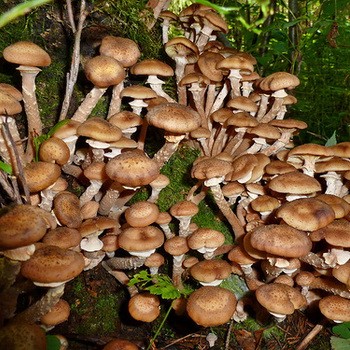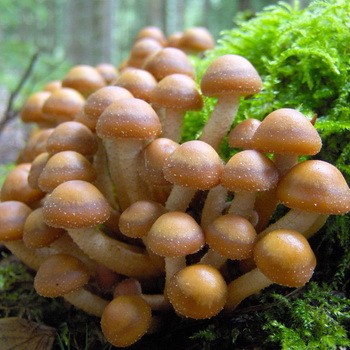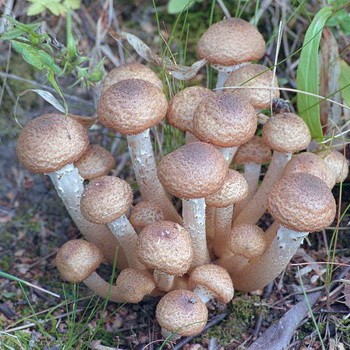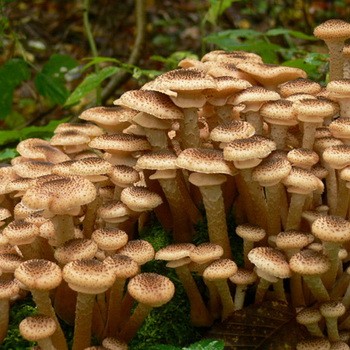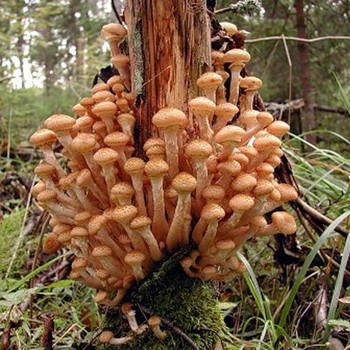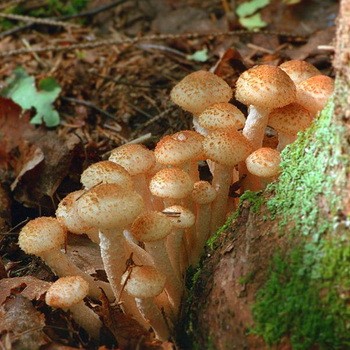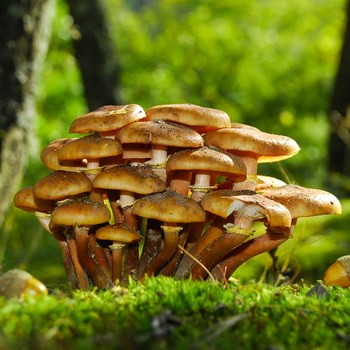Autumn and "assumption" honey mushrooms in the Tula region
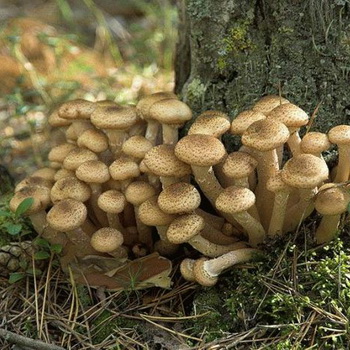
The Tula region has always been proud of the presence in its forests of popular and beloved species of mushrooms: russula, chanterelles, boletus, boletus and butter. In addition to these fruiting bodies, autumn, summer and winter mushrooms grow in the Tula region. That is why lovers of "silent hunting" should visit all the forests of this region.
Where honey mushrooms grow in the Tula region, only inveterate mushroom pickers know. But they sincerely share this information with novice "hunters" for mushroom harvest. For example, mushroom mushrooms are located in the Tula region mainly in the northwestern and northern parts. In broad-leaved and small-leaved forests, in which birch, oak, linden, and aspen predominate, you can safely pick a wide variety of mushrooms, including popular and fast-growing mushrooms. On the border with the forest-steppe in the southern region, in oak-ash forests and forest plantations there are autumn or "assumption" mushrooms. Autumn species of honey agarics is called so because they begin their rapid growth precisely on the Orthodox holiday of the Blessed Virgin Mary. On this day, you can safely go to the forest for mushrooms, and believe me, you will not come back empty-handed.
Content
Are there mushrooms in the Tula region and where to look for them?
Where in the Tula region autumn honey mushrooms grow, and in which forests can you go for them? The most popular area among the local population is Suvorov District. Forests near the settlements of Suvorovo, Hanino and Chekalino are called especially mushroom.
Mushroom places for the distribution of honey mushrooms in the Tula region are forests near the village of Spitsino, as well as near the village of Ozerny. In deciduous and pine forests located in the Aleksinsky district near the village of Aleksino, you can collect not only honey agarics, but also chanterelles, russula, oleaginous.
All fruiting bodies prefer to “collaborate” with certain plants. Therefore, every mushroom picker knows where to search for honey mushrooms in the Tula region. These mushrooms are preferred by birch, linden, acacia, ash, oak, less often they can be found in pine forests. Sometimes honey agarics can even choose the roots of shrubbery plants. However, the trees on which they settle are dying or "sick." Honey mushrooms give great preference for their settlement to rotten stumps, tree trunks felled by a windbreak or fallen branches.
Many beginner mushroom pickers ask if there are mushrooms in the Tula region in the Leninsky district? In the area of the settlement Demidovka in deciduous forests you can find autumn mushrooms, as well as saffron milk cap and oily. Dubensky district in the Tula region is rich in “assumption” mushrooms. In these broad-leaved forests, dominated by birch and oak, there are a lot of mushrooms, especially since the trees mentioned are in wetlands. Gullies in this territory abound with meadow honey agarics.
Where else can you pick mushrooms in the Tula region and when to collect them?
And where else can you pick mushrooms in the Tula region? In the Kimovsky district, near the village of Bugalki, there is a beautiful forest with an abundance of different fruiting bodies, including honey mushrooms. But in the Yasnogorsky district in mixed deciduous forests you can collect not only autumn mushrooms, but also winter ones. For mushroom pickers with winter mushrooms, there are no problems at all, because these fruiting bodies do not have false counterparts. In addition, winter mushrooms are very tasty and contain many useful vitamins for the human body.
For those who are just starting their mushroom experience, I want to note that you need to know the dates when to collect mushrooms in the Tula region. Typically, the collection season begins in the month of July and continues until the end of October. But if there is warm and sunny weather, then the dates are shifted until mid-November. However, the peak of gathering oil still falls at the end of August, as well as the month of September. To find the most mushroom places, you need to go to the forest in the early morning, when there is still fog in it. Winter mushrooms begin their growth in October and continue until March. In severe frosts, these fruiting bodies do not disappear, but “fall asleep”. And when there are thaws, they begin to grow again. They can be collected even under a layer of snow.
Fallen rotten tree trunks or stumps left after felling are excellent territories for collecting honey mushrooms. Forest plantations and forests of the Odoyevsky district have always attracted lovers of “silent hunting”. Once in these territories only once, you will come back here for mushrooms every year - these forests will give you an unforgettable experience, including large mushroom crops.
Mushroom places where honey mushrooms are harvested in the Tula region
There are several more places in the Tula region where honey mushrooms are collected. So, many people mark a pine forest near Aleksino or Kornitskaya Zaseka. Forests rich in honey agarics in the Chern and Efremov regions. I want to say that almost all the forests of the Tula region, especially where there is a lot of heat and moisture, are rich in various types of mushrooms, including everyone's favorite mushrooms. During the summer-autumn period, each mushroom picker can visit several waves of growth of fruiting bodies. This time may include up to 4 waves of mushroom picking.
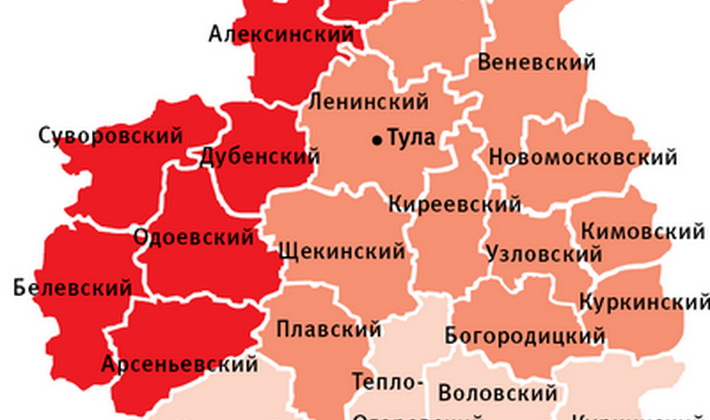
For example, having left Zaitsevo in the direction of Voskresensk, there are forests along the road where there are a lot of honey mushrooms. Sometimes the mushroom picker has no time to straighten its back, as honey mushrooms grow in large colonies here.
I would like to note that in the vicinity of Tula there are also many places where you can collect honey mushrooms. However, experts advise against this, because in the urban areas there are many industrial enterprises that adversely affect the environment. Mushrooms have the ability to absorb all harmful substances, including salts of heavy metals. For this reason, eating such mushrooms is harmful.
Mushroom pickers with experience have identified walking paths for beginners who love "quiet hunting", indicating where mushrooms can be picked up in the Tula Region. These forest areas are easily accessible by car or train.
For example, to get to the forest near the village of Volchya Dubrava, which is located in the Teplo-Ogarevsky district, you need to go from the bus station Tula by bus "Tula-Efremov" or "Tula-Teploe". On the road you will need only 1 h 40 min.
To get to the Karnitsky villages, in the Venevsky district, you need to leave the Zarechye bus station on the Tula-Venev bus to the stop at the Zasechny settlement. From the village to the forest is only 4 km. Therefore, you will spend about 2 hours all the way.
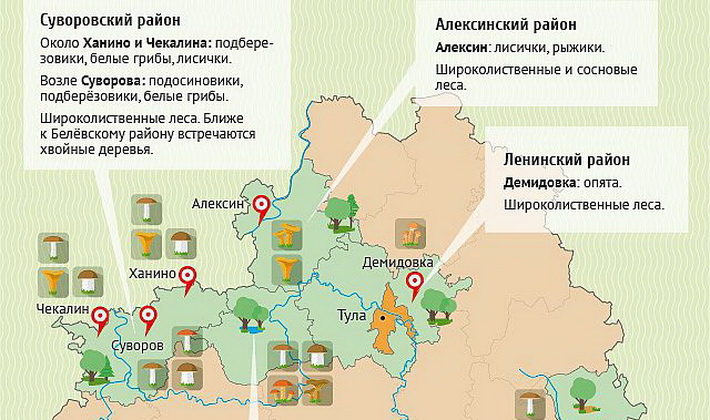
If you want to wander in a pine forest near Aleksino and collect mushrooms here, you need to leave Tula by minibus to the Aleksino stop, then go beyond the village and walk to the boron. Travel time will be only 1 hour.
Mushroom places where honey mushrooms are collected in the Tula region, mushroom pickers are called Chernsky, Belevsky and Suvorov districts. In addition, experts note that it is on the territory of these forests that the cleanest mushrooms grow in terms of ecology.
I would like to note that any area of the Tula region, where forests are located, is mushroom.If it is not possible to get minibuses to the goal, use the trains. All forests in the region are environmentally friendly, and therefore fertile.

